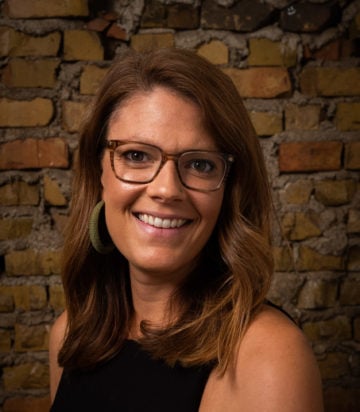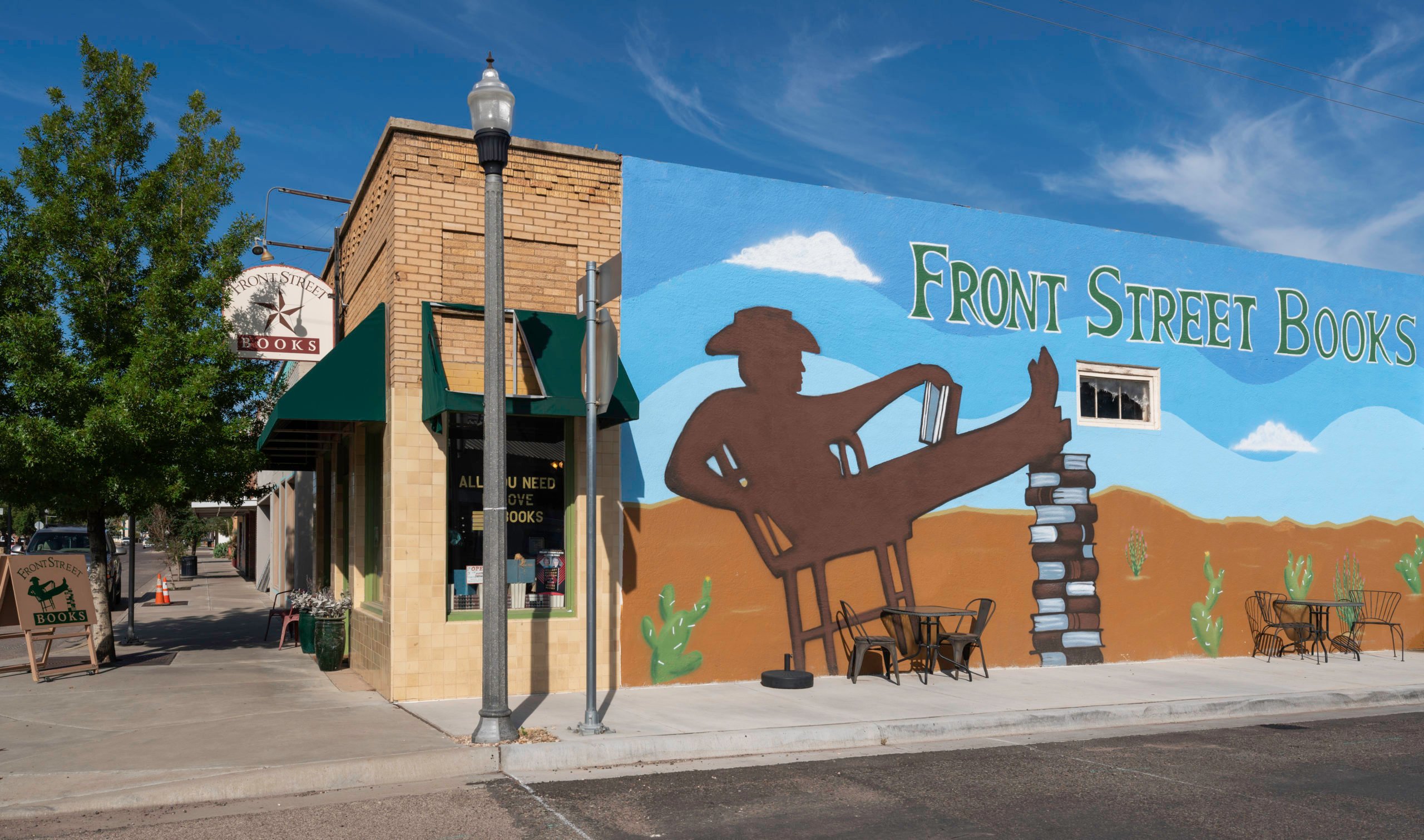Building Trust
As Texans face the skyrocketing cost of housing, community land trusts offer the promise of permanent affordability. You just have to give up ownership of your land.
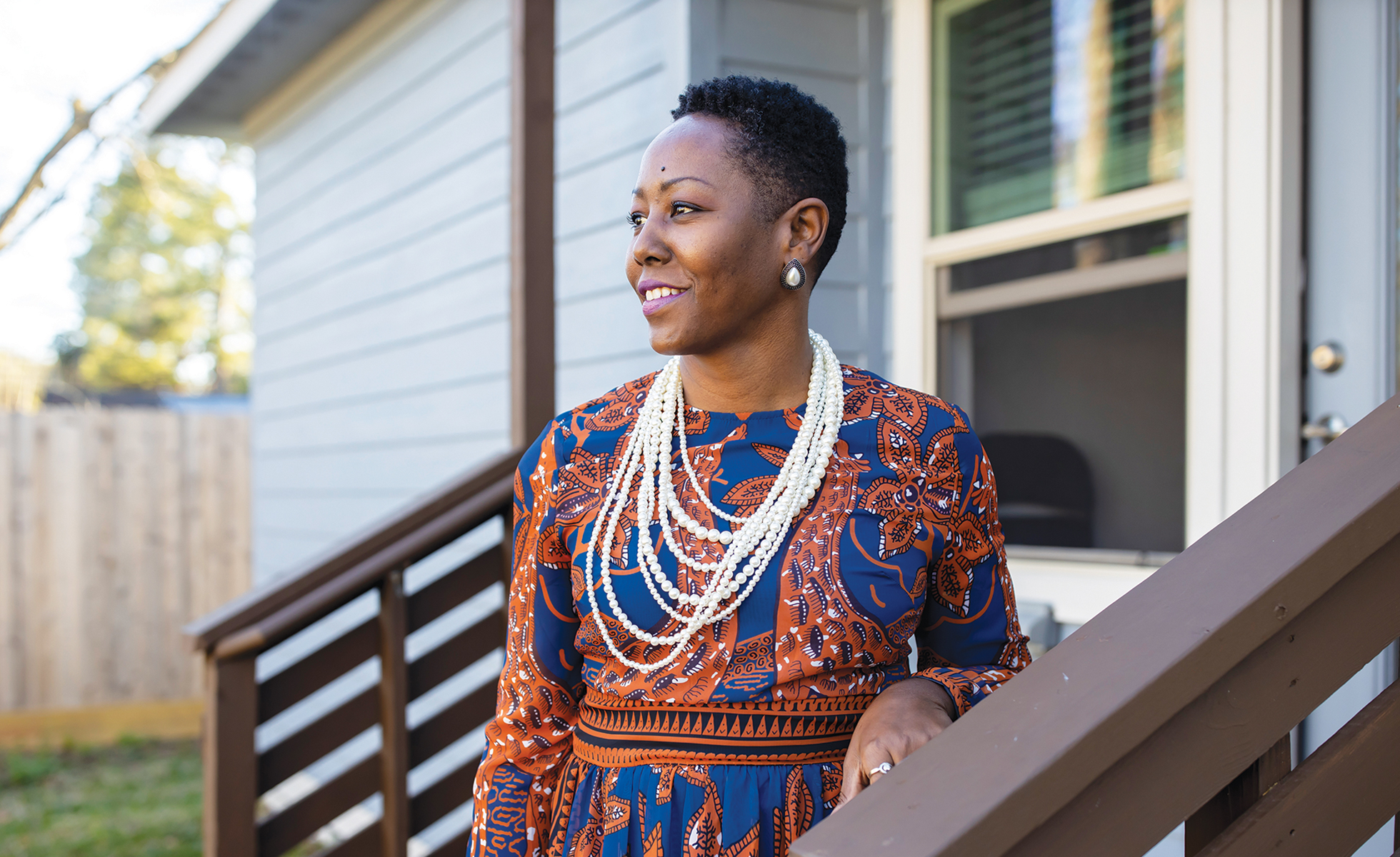
By Megan Kimble
April 7, 2020
Early last year, Regina Daniels decided it was time to buy a house. She’d been renting a three-bedroom apartment off Antoine Drive in Houston’s Acres Homes neighborhood, an area she’s loved ever since her family moved there when she was in high school. “It’s homey,” she says. “Neighborly.” Unincorporated until 1974, Acres Homes was originally marketed to black Houstonians as “a bit of genteel country,” named for the acre of land you’d get with your house. Though it’s just 20 minutes northwest of downtown, the neighborhood is quiet, sheltered by stands of pine trees and the occasional farm.
But the rent at Daniels’ apartment was about to go up again—she was already paying $1,200 a month—and she was tired of moving her three kids to a new place every time it did.
So she started looking at houses in the neighborhood, where the median list price had climbed above $200,000. “I was going to have to make some major sacrifices,” Daniels says. “I was going to end up mortgage-broke.” She considered Habitat for Humanity, but it wasn’t building in the area. One day, Daniels got a call from a friend, who told her about the Houston Community Land Trust (CLT), a newly formed nonprofit selling affordable homes in the neighborhood.
Within two months, Daniels had moved into a brand-new three-bedroom house just south of Little York Road.
On a humid night in October, her 5- and 6-year-old sons, Matei and Keeland, wriggle around the living room and list all the things they love about their new house. Matei likes the backyard, where there are three trees, where sometimes the ball goes over the fence, where he steps on ants and stares at the clouds in the sky. “I can tell you which weather it is,” he says, proudly.
Daniels pays $725 a month for her home, $675 of which goes to the bank for the 30-year mortgage on the house. The remaining $50 goes to the Houston CLT for the 99-year ground lease on the land, which the nonprofit owns.
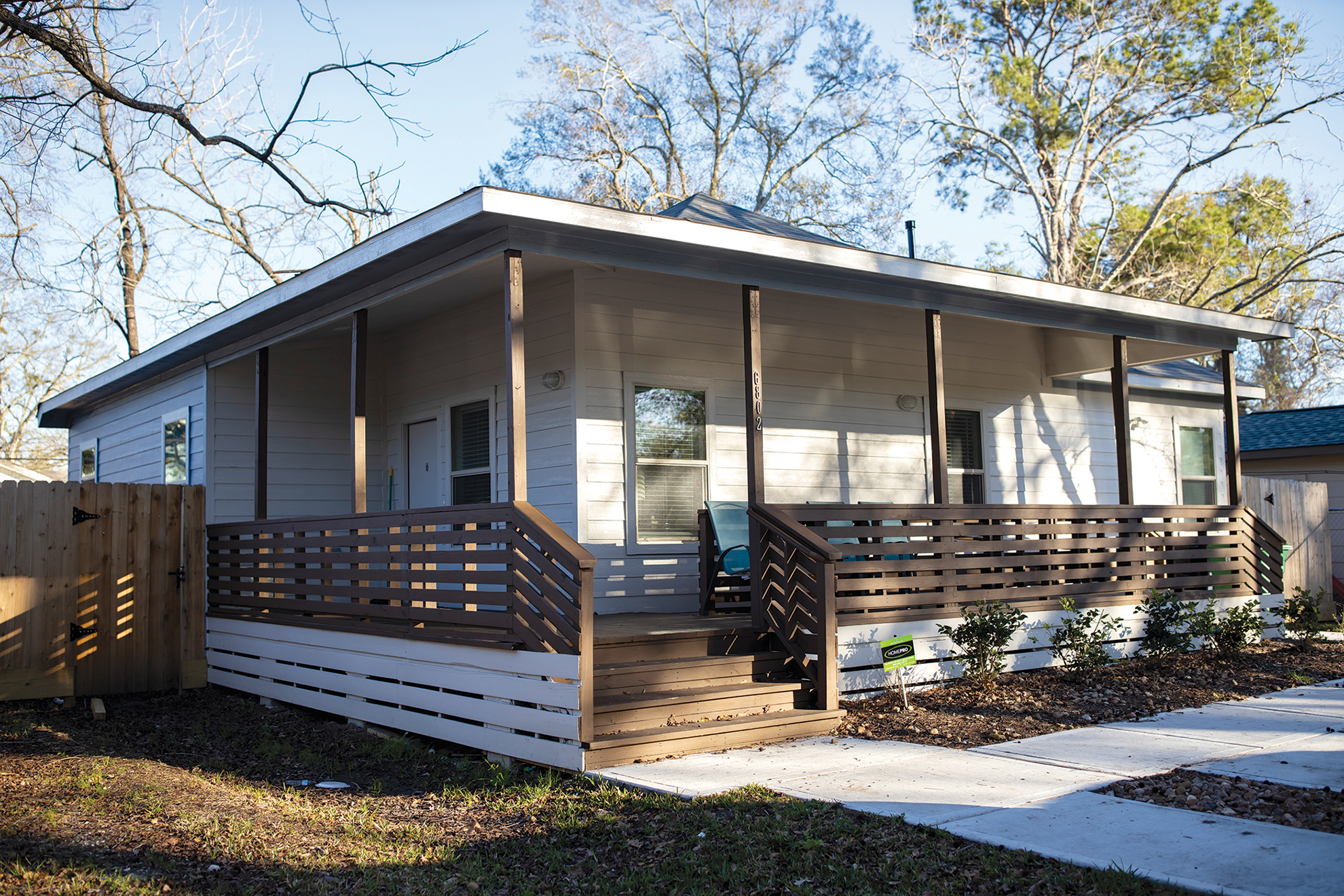
It doesn’t bother Daniels that she doesn’t own the land under her house. “It used to be the only thing I could think about was which money I was going to move around in order to take care of things,” she says. Now she can think beyond her next payment—to save for retirement, to pay for the braces her daughter needs.
Texans have seen the cost of housing skyrocket over the past decade. As a result, populations of “at-risk groups”—low-income residents and black and Hispanic families—have declined in city centers and concentrated in outlying suburbs, where housing is cheaper. In January, an analysis by the Federal Reserve Bank of Dallas found that Houston has gentrified faster than any other Texas city, with neighborhoods near downtown seeing spikes in median income as affluent people moved in. But no city is immune. The same thing has happened in Austin and Dallas and, to a lesser extent, San Antonio, where change appears all but inevitable.
Cities have largely struggled to protect affordable housing in gentrifying neighborhoods. Once the engine of capital revs up and investors begin to speculate on a plot of land’s future value, the machine is hard to stop. The community land trust model offers an elegant solution: By separating ownership of a house from the land beneath it, you can ensure the home remains affordable—permanently.
Since 2011, every big city in the state has either established or is working to establish a community land trust. Austin has two. A Dallas nonprofit and the City of San Antonio are both actively working to start CLTs. Smaller cities are following suit; even advocates in Abilene—population 122,999—are looking at the model as housing costs creep up.
The force behind Houston’s CLT is Tom McCasland, director of the city’s Department of Housing and Community Development. When he started his job in 2016, he quickly became frustrated with the limitations of traditional housing assistance programs, which offer down payment support to low-income homebuyers or subsidies to developers who commit to preserving affordability for a certain number of years. Once a homebuyer moves or the period of affordability expires, the unit returns to the open market, often jumping in price and erasing the effects of any public subsidy.
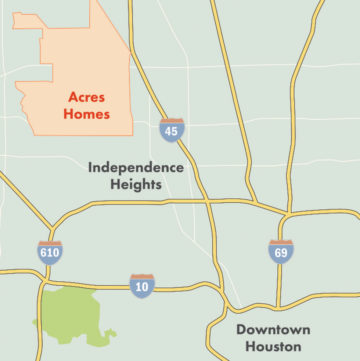
“It felt like we were on a treadmill and the treadmill was turned up too high,” McCasland says. “We had more units rolling out of affordability and into the open market than we were putting in. The affordable housing crisis was just getting bigger and bigger despite us working as hard as we could to try to address it.”
In November 2018, the Houston City Council approved $1 million to start the Houston CLT as an independent nonprofit, with the goal to build or convert 1,100 homes into the trust over five years. If successful, Houston’s CLT would surpass the country’s largest, the Champlain Housing Trust in Burlington, Vermont, which was established in 1984 with the support of then-mayor Bernie Sanders and today holds 615 houses and 2,300 apartments.
Now McCasland’s department builds houses on formerly vacant or tax-delinquent property held by the Houston Land Bank, which has earmarked 260 abandoned properties across the city for affordable single-family housing. Qualifying homebuyers—families who make less than 80 percent of the area’s median income—can choose to pay roughly $180,000 for a house and the land. Or they can put the land into the Houston CLT and pay for just the structure, about $80,000, and agree to a resale restriction that limits how much the home can appreciate in value.
People presented with this choice have overwhelmingly decided to buy CLT homes—of the 16 that had been sold as of February, 12 had gone into the land trust. “This isn’t just about one individual homebuyer,” says Ashley Allen, executive director of the Houston CLT. “It’s about protecting and preserving communities as a whole. Even if you win the lottery tomorrow and sell the house to move into your mansion, someone else is going to be able to benefit. People who are community-based people, who have been in a community forever, that resonates with them.”
In 1879, a journalist in San Francisco named Henry George published a book called Progress and Poverty. In it, George noted that the appreciation in the value of unimproved land was often the result of a communal effort—a new commercial district, a railroad—rather than individual enterprise, and yet it was the individual landowner alone who profited. “Why should a man benefit merely from the act of ownership, when he may render no services to the community in exchange?” George asked.
His conclusion: “The great cause of inequality in the distribution of wealth is inequality in the ownership of land.”
He proposed a land-value tax that would redistribute the wealth generated by undeveloped land to the community, while preserving private ownership of (and profit from) the improvements built on that land—buildings, farms, factories. George proposed eliminating all other taxes in favor of this single tax on land, a mechanism he asserted would redistribute wealth without hampering economic development. Progress and Poverty became a bestseller, catalyzing the creation of numerous “single tax” colonies everywhere from Delaware to Israel based on community ownership of land and individual ownership of improvements.
Eighty years later, in the early 1960s, civil rights activists in rural Georgia were struggling to build a movement of sharecroppers, black farmers who worked and lived on white-owned land. An activist and reverend named Charles Sherrod had been organizing sit-ins and voter registration drives, knocking on doors across the state. But, as he recalled in a 1981 interview, he kept hearing the same thing: “What are you going to do if I get kicked out of my house?” The threat of eviction was real—black people had been kicked out of their homes for less than registering to vote. “The only solution that one could come to would be that we have to own land ourselves,” he said.
But at the time, even black farmers who did own land were losing it at alarming rates. From 1954 to 1964, according to the U.S. Census of Agriculture, nonwhite farmers in Georgia lost 65 percent of their land. “The whole effort was to try to make sure we developed a system so that the land would always be there, so that the land would be owned by everyone,” Shirley Sherrod, Charles’ wife, tells me.
The system they eventually built was inspired by George’s vision of communal land tenure. New Communities, widely regarded as the first community land trust in the country, would be “a nonprofit organization to hold land in perpetual trust for the permanent use of rural communities,” according to its founding documents.
In 1969, the nonprofit organized the purchase of 5,735 acres outside Albany, Georgia—at the time, the largest parcel of black-owned land in the country. They planned to build more than 500 homes, a school, and a health center, but first, they needed money to pay for the land. So they started farming. Fifteen families moved into existing structures, and many more showed up to help build the fledgling community. Together, they built a greenhouse, nursery school, and grocery store. Families came from all over Lee County to help pick peas or harvest okra on the farm, says Phillip Davis, who grew up in a small cinder block house on the property.
The farm thrived for seven years, until a drought hit in 1976. When the community applied for an emergency loan from the local Farmers Home Administration, Shirley remembers, a white supervisor said: “You will get a loan here over my dead body.” In 1985, they lost the farm to foreclosure.
By then, the community land trust model had spread across the country, becoming an increasingly urban phenomenon, writes James Meehan in Reinventing Real Estate: The Community Land Trust as a Social Invention in Affordable Housing. At the first national CLT conference in 1987, 24 land trust representatives showed up; by 2006, there were 162 CLTs operating across the country. Last year, according to a report by Fannie Mae, there were 225 community land trusts operating across the United States, representing 20,000 rental units and 15,000 homeownership units.
In October, people from many of those CLTs gathered in Albany for the 50-year anniversary of New Communities. “You have to keep working and have faith that things will work out,” Shirley tells the 200-odd people gathered in a giant white tent erected at the crest of a rolling property. A banner welcomed cars turning right onto the former plantation: “This land was owned by the largest slave owner in Georgia and is now owned by the descendants of slaves.”
In 2009, as part of a class-action lawsuit alleging that the USDA had discriminated against black farmers, New Communities won a $12.8 million settlement. Now, on this 1,600-acre parcel of land, they’re farming again: Squash and collards grow alongside satsuma mandarins and muscadine grapes. There are more than 8,000 pecan trees planted in orchards across the property, the ground dappled with spotted husks.
“It’s tough to ingrain in people to think of ‘we’ versus ‘I,’” Charles and Shirley’s son, Kenyatta, tells me as we stand in the shade below a sprawling live oak. “You have to bring them onto the property, then they get it—that no one person can do all this on their own. When you share it, it’s still part yours.”
Growing up in East Austin in the 1970s, Johnny Martinez used to ride his bike past a field off Tillery Street—he remembers it because of the giant pecan tree in the distance. “I always wanted to go back there,” he says. But the tree was behind a fence and the field was full of debris, so he never did. Martinez grew up; he got married and divorced, started raising his 8-year-old daughter on his own, and went to school to become an HVAC tech, moving in and out of apartments as the companies he worked for as a maintenance supervisor offered discounted rent.
The complex he works at now on 11th Street, across from Franklin Barbecue (“I go to work at 7:30 and there’s already a line”), charges $1,800 per month for a studio apartment. The neighborhood he grew up in “has changed big-time,” he says. “It has its ups and downs. The down is that affordable housing is no more in East Austin, trust me.”
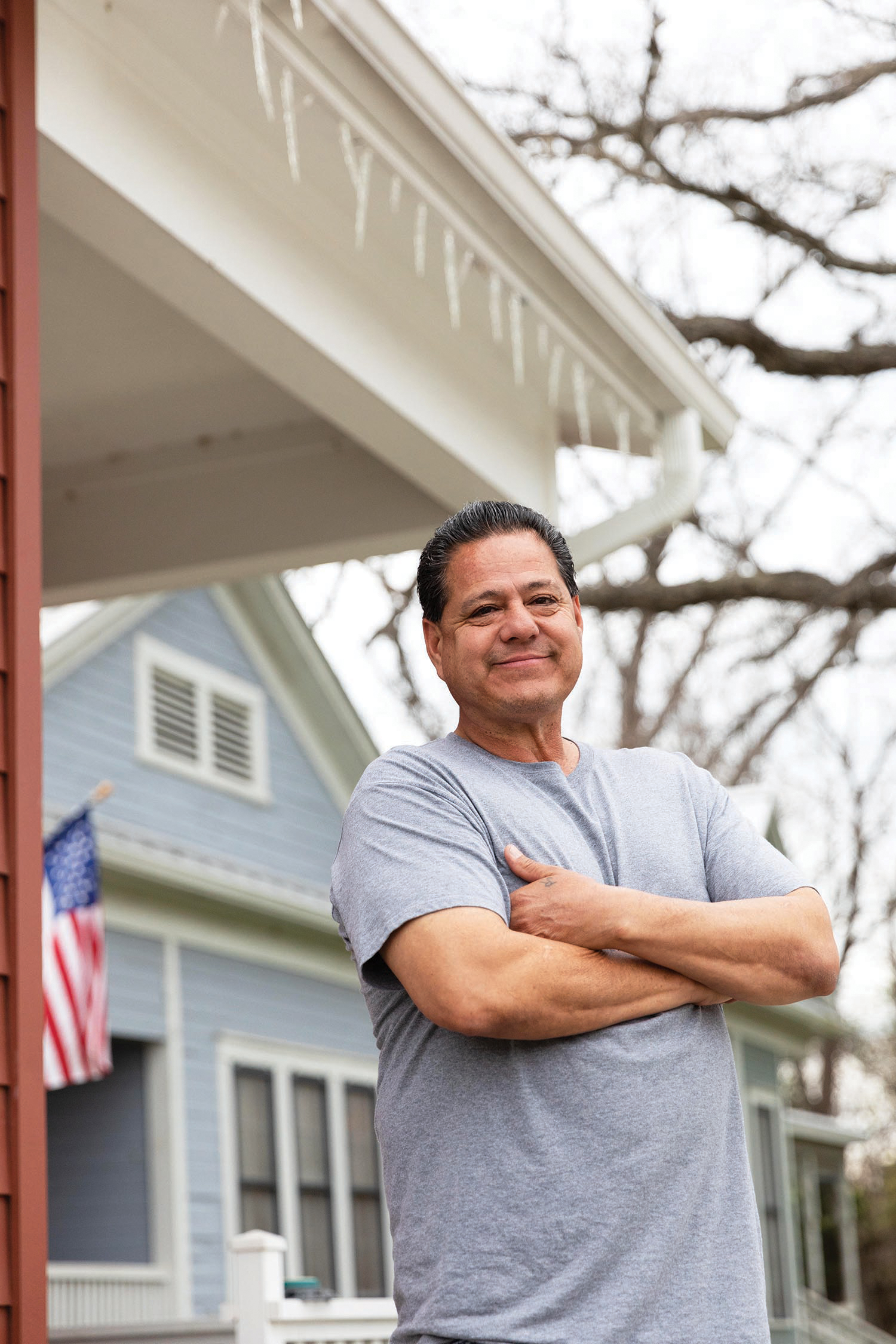
Before that was the case, in the early 2000s, Martinez ran into a high school classmate who worked for Guadalupe Neighborhood Development Corporation (GNDC), an affordable housing nonprofit in East Austin. At the time, the average home in the area was selling for $84,000, compared with $142,000 citywide. The issue was vacancy, the cratering of a neighborhood as longtime residents moved out and commercial developers moved in from downtown. Since 1983, GNDC had been buying homes in foreclosure or at cost, rehabilitating them using city funds, and selling those homes back to people from the neighborhood. If a homeowner decided to sell the home, GNDC had the right of first refusal to buy it back and resell it to another low-income buyer. They weren’t worried about the home appreciating in the meantime: “No one wanted to live over here anyway,” says Mark Rogers, GNDC’s executive director. “These people did because that’s where they’d always been.”
He was disabused of that notion in 2005, when he got a call from a couple who had purchased a home from the nonprofit two years earlier for $105,000. They wanted to sell and had already gotten an offer—for $213,000. It was far more than GNDC could afford. “We realized, this doesn’t work anymore,” Rogers says. His realization was prescient. Home prices would only continue to climb across East Austin, doubling from a median of $235,000 in 2010 to $481,000 today.
Heather Way, a University of Texas law professor then working with affordable housing nonprofits across the state, had heard about the community land trust model. “This kind of structure of severing the land and the real property is done all the time in the commercial real estate market, but for homeownership, for Texas, it had been a new form,” she says.
Way, Rogers, and others worked with state Senator Royce West to define and enable community land trusts in the state’s property code, finally passing a bill in 2011. In 2012, GNDC built the first CLT home in Texas—a tidy mint-green A-frame house with three big windows and a white wraparound porch on the corner of Willow and Navasota streets. The nonprofit now has 18 owner-occupied homes scattered throughout East Austin, with 14 more under construction. The City of Austin has a land trust now, too, with 17 homes across the city and another 20 scheduled for construction this year.
After GNDC built its first community land trust home, “The real question was, how are we going to get TCAD [Travis County Appraisal District] to value this?” Rogers says. Appraising the house was relatively straightforward: A deed restriction limited how much the house could be sold for in future years—a value TCAD could tax. The land was more complicated. The trust’s 99-year ground lease prevented both the family and GNDC from selling the land on the open market. How do you value land that can’t be sold?
After years of wrangling, TCAD agreed to tax the land based on the nominal rental income GNDC was earning from its ground leases, currently $300 a year, saving CLT homeowners thousands of dollars in property taxes. Rogers and Way have tried for the past two legislative sessions to pass a bill that would formalize CLT appraisals statewide. “That would be revolutionary,” Rogers says. “Texas would be way ahead of the rest of the country.”
In 2011, GNDC started developing a former dumpsite off Tillery Street. It had acquired most of the 11-acre parcel in 2005 in tax foreclosure and planned to build a CLT subdivision with 54 single-family homes, four duplexes, and 24 townhouses. In 2015, Rogers asked Martinez, who was working for GNDC by this time, if he wanted to buy a home. “I said, of course I would,” Martinez says. Three years later, he moved into a three-bedroom, two-and-a-half bathroom house on Father Joe Znotas Street. He pays $890 a month for the mortgage and $2,100 a year in property taxes; his sister, meanwhile, is struggling to keep up with the nearly $7,000 tax bill at their mom’s old house on Canterbury Street. (Because TCAD uses a different valuation method, CLT homes don’t affect the property values of surrounding market-rate homes.)
Martinez is happy to be back in the neighborhood he grew up in. If the weather is nice, after work, he rides his bike down Tillery and over to Cherico Street, past Govalle Elementary, where he went to school. Standing in his backyard, he can see the pecan tree in his neighbor’s front yard—the same one he used to bike past all those years ago. “Now I’m right next to it,” he says. “Kinda weird.”
He’s grateful for his home. But he’s occasionally skeptical about its future. “If you plan on staying and handing it down to your kids, you are kind of leery of what’s going to happen after 100 years,” he says. The ground lease tied to his home is renewable and transferable to his heirs, but, he says, it’s awkward not to know for sure. “You try not to put too much thought into it because it’s a long way away.”
Martinez’s concern echoes a common critique of community land trusts: How secure can you really be if you don’t own the land below your home?
“I question the premise that anyone actually individually owns their land,” says Jason Webb, a senior specialist at Grounded Solutions Network, a national membership organization of community land trusts. “If you don’t pay your taxes, what happens? The taxman is going to come and take your entire property, not just the land.” If you don’t pay your mortgage, the bank will do the same.
That is precisely what happened during the Great Recession, which disproportionately impacted homeowners of color. A 2011 study of the housing crash found that Hispanic and black households lost 66 percent and 53 percent of their wealth, respectively, between 2005 and 2009; the average white family lost just 16 percent.
In 2018, Grounded Solutions partnered with the Lincoln Institute of Land Policy to examine the efficacy of shared equity homeownership programs like CLTs. The study, which looked at 4,108 properties across 20 states over three decades, found that foreclosure rates in shared equity homes were astonishingly low: 99 percent of shared equity homeowners avoid foreclosure.
But like any investment, there are fewer downsides to a CLT home precisely because the upsides are so limited. “Our program only allows a family to build wealth at this very incremental pace,” says Nina Culotta, the housing director at the Houston CLT. “I think people balk at that. They’re like, ‘You’re holding folks back. You’re not allowing people to enjoy the full benefits of being a homeowner.’”
Of course, families of color were lawfully excluded from enjoying the full benefits of being homeowners for more than half a century. The consequences of that exclusion are still reverberating today. According to the Federal Reserve, the median net worth for a white household is $171,000, compared with $17,600 and $20,600 for black and Hispanic households, respectively, a disparity that can be attributed at least in part to low rates of homeownership among black and Hispanic families.
“We are trying to provide opportunity to a population that has historically not had an opportunity to enter the housing market,” says Ashley Allen of the Houston CLT. A CLT home is a starting point, Allen says—a stepping stone between renting and owning. “Even if you’re not building [as much] wealth through the actual home, you’re building wealth by being able to save. You’re building wealth by having stability and being able to pay your mortgage and having something left over.”
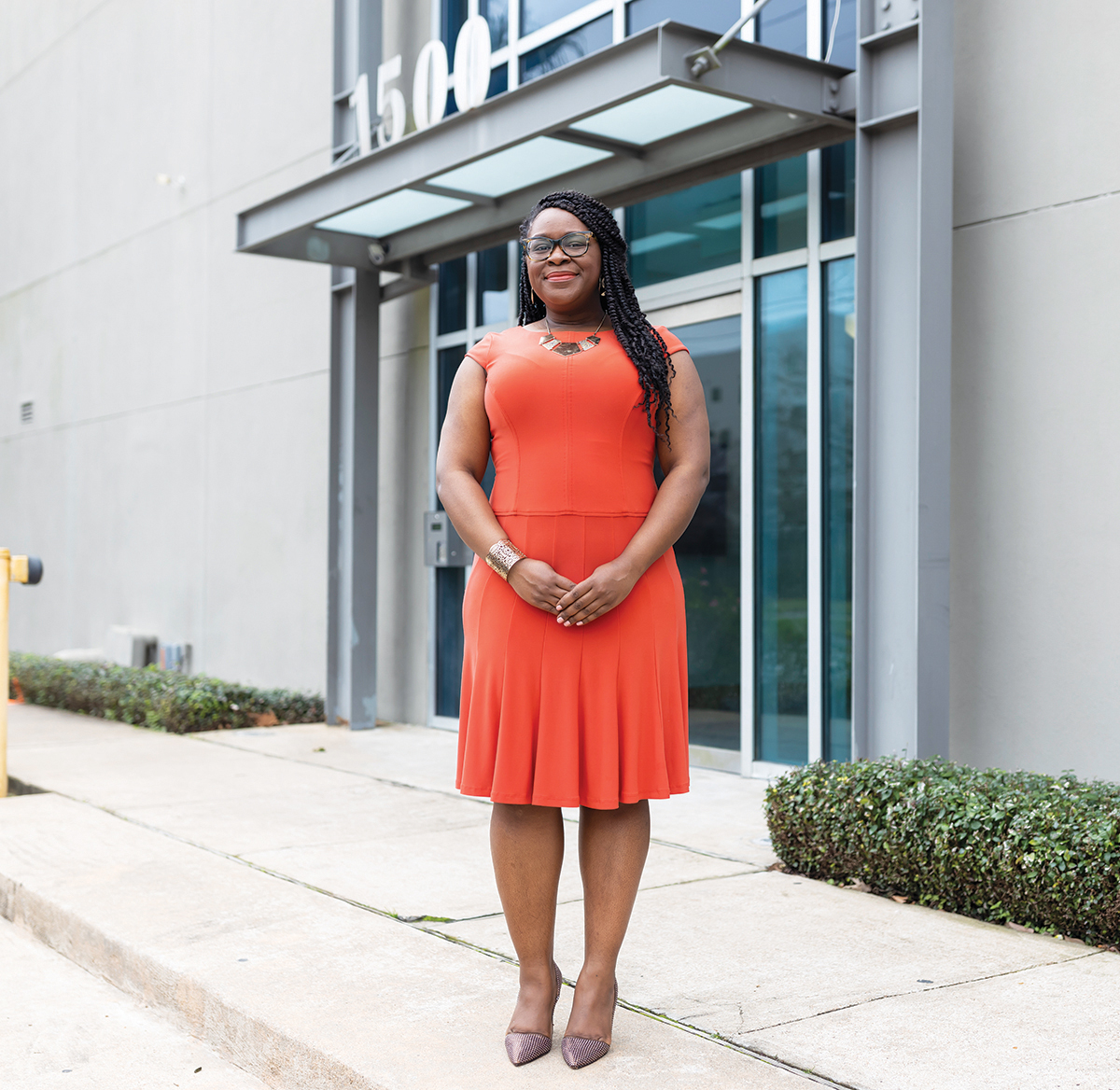
According to the U.S. Census, the average homeowner’s household wealth is $228,200, compared with $2,523 for the average renter. People in CLT homes fall somewhere in between: The average shared equity homeowner accumulates $14,000 in equity during their time in the home.
Allen says the land trust gets pushback from people who have already benefited from traditional homeownership. “One of our biggest critics was a VP at Bank of America,” she says. “Of course, you don’t need this program!”
Over the past couple of years, Rogers, of GNDC, says, he’s started to get calls from city planners in unexpected places—Lubbock, La Grange—who have seen housing costs rise rapidly while incomes remain stagnant. The time to invest in a land trust, he says, is before gentrification hits, when land can still be acquired affordably. He still kicks himself for turning down two riverfront lots in Austin selling for $16,000 apiece two decades ago.
That’s exactly what’s driving advocates in Abilene to push for a CLT. Although the average rent there is still only $745 a month, it’s beginning to climb. “Gentrification is a slower process here, but it is starting to happen,” says Rosten Callarman, who is working with neighborhood groups to start a CLT. “If we’re learning anything from the larger markets, it’s that now is the time to get ahead of it.”
Taped to the bright white door of Stephanie Dickerson’s house in Acres Homes is a swatch of royal purple paint. After two decades of renting, Dickerson is delighted that she doesn’t have to ask permission to paint her door. “As you can see, I like color,” she says. “Purple is a color of wealth, but it’s wealth in spirit, not wealth in money. Your home is peaceful, your heart is peaceful.”
Inside the house on Bethune Drive, peace does not yet reign supreme, as Dickerson’s 2-year-old grandson, Zayden, careens up and down the (pistachio green) hallway. Dickerson’s son, Patrick, recently moved back to Houston from San Diego with his partner and two kids; they’re staying with Dickerson until they find a place of their own.
Dickerson, who moved into her house in July, was initially skeptical of the land trust model. “How are you going to own the house but don’t own the property?” she asked her aunt, who’d told her about the Houston CLT. “But when I was able to get the house for the amount that I got it for, I was like, that makes a lot of sense.”
Acres Homes wasn’t her first choice of neighborhood—she had been living in Humble, near the airport, and works in The Woodlands. But that’s where the land trust had homes, and Dickerson wanted a home.

That’s about to change. Starting this spring, qualified homebuyers will be able to search for houses on the open market anywhere in the city. If the house meets certain standards—it can’t be more than 10 years old or in a flood plain—the city will provide roughly the same subsidy it’s putting into new-construction homes if the buyer puts the home into the Houston CLT. If successful, this so-called homebuyer choice program would radically and rapidly expand the number of CLT homes across the city. “We get calls every day: ‘When are you coming to our community?’” Allen says. “This would be an opportunity to create affordability in communities that we know are rapidly changing.”
Many people still balk at the investment required by a CLT—in Houston, the city puts in roughly $105,000 per home. “The question all along has been: Is this scalable?” McCasland says. “We won’t know until we try. Yes, the upfront subsidy is expensive, but if you spread that out over the five-plus families that are going to be living there for the next 30 years, it starts to become a very reasonable subsidy—in fact, far more reasonable than our current interventions.”
In 1950, the average family income in the United States was $2,990, while the average home cost $7,400, equivalent to two and a half years of income. In 2018, the median household earned $63,179, while the median home sold for $325,275, representing more than five years’ worth of income. One reason for that growing divide is the rising price of land. According to a 2017 study, “rising land prices explain about 80 percent of the global house price boom that has taken place since World War II.”
As housing costs skyrocket across the United States, Henry George’s notion of socializing the wealth generated by land has begun to appear more and more reasonable, supported by economists and urban planners across the country. “George’s idea was if you tax the full rental value [of land] then no one would buy land just in the expectation that the price would go up in the future,” says Joan Youngman, a senior fellow at the Lincoln Institute of Land Policy. “Because, as the price went up, the tax would go up. You would only benefit from what you did with the land.”
A community land trust is one way to remove the profit motive from land ownership; a land tax is another. Either way, the fundamental question now facing cities across the country is one George asked more than a century ago. Who benefits from the rising price of land?
Homeownership has transformed how Dickerson sees her life. She has a day job, but now that she has a home office and a stable mortgage, she’s working to start her own business doing medical billing. When she works for herself, she’ll finally be able to go on vacation—she wants to go to Cameroon, where her ancestors are from.
She is also the first in her immediate family to own a home. Four months after Dickerson moved in, she still occasionally calls her mom just to whisper, “Mom! I got a house.”
Her mom replies, whispering too: “You got a house.”
This story was supported by the Solutions Journalism Network, a nonprofit organization dedicated to rigorous and compelling reporting about responses to social problems.
This story is the from our special issue on housing. This issue also marks the start of our new housing beat.
